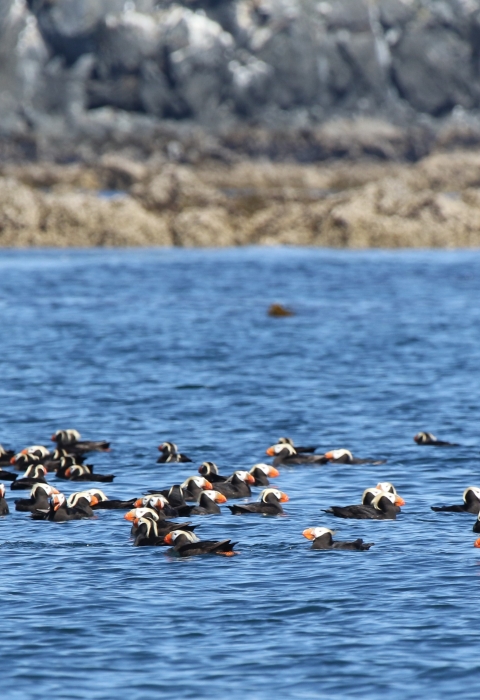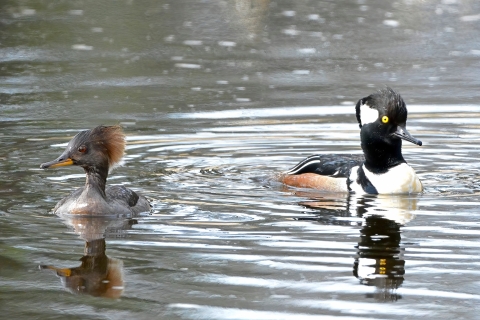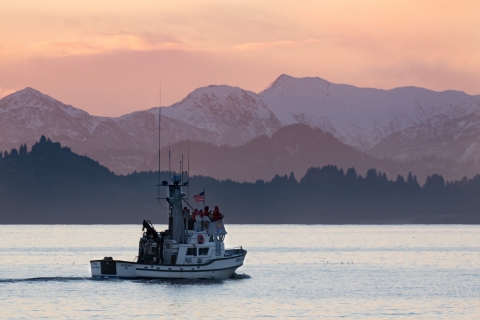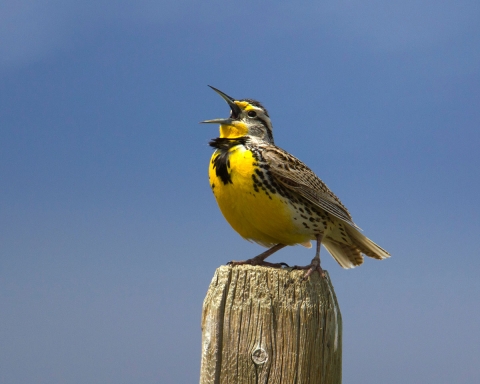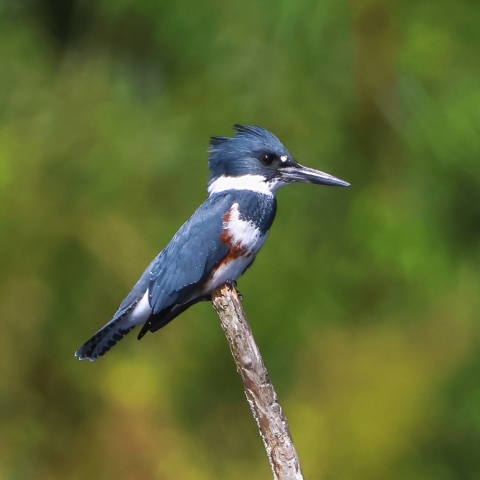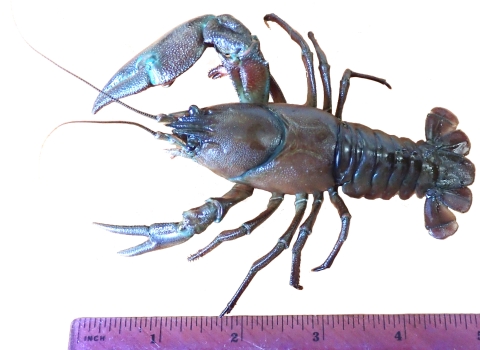In Alaska, the U.S. Fish and Wildlife Service employs a small army of dedicated and passionate staff with a large spectrum of roots. Some were born and raised in Alaska. Others have come from around the world. Regardless, some stay to do a job they feel is important enough to spend a lifetime doing. Robin Corcoran, a bird biologist, talks about how she found herself in Alaska after moving here from the East Coast.
What do you do for the U.S. Fish and Wildlife Service?
I'm the bird biologist at Kodiak National Wildlife Refuge and I'm in Kodiak, Alaska. My favorite thing about what I do is that I get to go to work, and basically do what I would be doing in my free time anyway. My time off, I'm often bird watching and taking photos of birds. That's like one of my major hobbies, and so I also get to do that during the workday, which is sort of a dream come true.
What do you like about birds?
One of the things I really like about birds is their diversity. They're more diverse than mammals. Just within like a single family, you'll have so many different types of behaviors. So not only do you have diversity in appearance, you have diversity in social structure and breeding biology. They're just endlessly fascinating to me, and I just never get bored. Plus, they're incredibly, incredibly beautiful.
How did you come to work with wildlife?
I was one of those kids who was just obsessed with animals, all animals, and I ended up going to a university where ornithology was huge. And so I think that my focus on birds really started in college. But before that, I just was crazy about everything in the natural world. I grew up on Long Island outside of New York City and you wouldn't think that there'd be a lot of natural habitat to play around in as a kid. But we were on the South Shore, about halfway out Long Island from the city, and there were still a lot of open spaces. I was lucky. One of the houses we lived in, we had woods that graded into a marsh that went all the way down to the beach, and I played there all the time as a kid. I loved it and it really connected me to the natural world. I got to do something that I think kids don't get to do as much these days: I got to play unsupervised. And oftentimes, you know, just myself and a few of the neighborhood kids, we just lived back there.
When did birds start becoming your focus?
I remember the ducks in the marsh. Those were the first birds that I really started paying a lot of attention to, especially hooded mergansers. These are just a hot little merganser. The male has a giant hood that he erects when he's displaying to the female. So I remember those. I started out my undergraduate career as a fine arts major. I had a lot of success with art throughout high school, but my art really always focused on wildlife. So I was always drawing and painting animals and nature scenes and that sort of thing. As an artist, you're just recreating what you see. That's great, but as far as sitting in a classroom and learning about things or reading a book about something, I felt like I learned so much more when I was focusing on the biology, the bird biology, the ecology, and the natural history, the taxonomy. Basically every aspect of bird biology really interests me, and I wanted to learn it.
So when I started out in fine arts as an undergrad, and I was just taking all art classes, I really pretty quickly decided that that was probably not the right route for me. I was able to talk to a fourth-year student who was a wildlife artist, a pretty successful one, and he suggested that I start taking more biology classes. By my second semester, I was taking a lot of wildlife biology and forestry and fisheries courses. And then I changed majors pretty quickly after my first year. Then for my senior year, I was able to get a work-study job with my ornithology professor. And one thing led to another. Then just after I graduated, I took a lot of seasonal jobs working for different organizations, on different birds all over the country.
How did you end up working in Alaska?
I think when I was younger, I saw the western United States — Montana, Wyoming, Colorado — as wild America and I wanted to go there. When I got into college, I started to dream a little bit bigger. I became fascinated with Alaska, just simply because it's so wild. And there are so few people and growing up on the East Coast and in New York, I just couldn't imagine what that would be like. I came to Alaska for the first time in 1993 to work on emperor geese in Yukon Delta National Wildlife Refuge. It was an amazing experience. I flew out and I spent three months in a tent on the Manokinak River. I worked with nine other people in this field camp. We nest searched every day and we tracked emperor geese, and tundra swans and glaucous gulls. And we did these tower sits where we'd go up into these towers for three days, and we'd look for our marked birds. And we weren't allowed to get out of the towers at all. We would just sit there with a big spotting scope and look for our marked birds and see how many emperor geese goslings were still with their parents. It was really exciting.
What kind of birds do you focus on?
So the nearshore marine bird communities are really important to our region, the nearshore ecosystem. So many people here rely on it for their livelihood. We're the third largest fishing port in the nation. The seabirds act as a really good indicator. We don't do a great job in Alaska of studying forage fish, because they don't have any commercial value. We look at salmon and we look at commercially important species, but we don't know, lower down the food chain, lower down on the trophic level, what's happening. Nearshore marine birds rely on the same sort of food that salmon or whales rely on. They're common, they're ubiquitous, they're really pretty easy to monitor in comparison to a lot of other species.
What do you do with nearshore marine birds?
The nearshore marine bird survey is a pretty big survey. We have a refuge research boat that we use as a floating sea camp; we travel around the archipelago, it takes us about three years to survey the whole archipelago because we have about as much coastline here as the entire state of California. My primary inventory and monitoring program is focused on nearshore marine birds, and I also survey mammals. So even though I'm the bird biologist, we have a lot of sea otters and harbor seals that are included in the survey. I do that in June, and I repeat it in August. In June, we're looking for population estimates and trends of our most abundant breeding species. Then in August, we go back out and we look at productivity. How well did the breeding birds do?
We have a lot of species of conservation concern here in Kodiak. So in addition to marbled murrelets, we have a lot of Aleutian terns. Tufted puffins are now a species of conservation interest, I would say. We have black-legged kittiwakes and glaucous winged gulls. Those are also two of our most abundant species. We have three different species of cormorants: pelagic, red-faced and double-crested. There are about a dozen species that are abundant enough that we can get good information on population estimates and trends.
Probably one of the most important is the marbled murrelet. It's a small relative of the puffin. It's a little brown bird. A lot of people are familiar with it because it's on the endangered species list in California, Oregon and Washington and also throughout British Columbia. And it's a very unusual seabird in that it nests solitarily on old growth, rather than in large numbers (like a lot of seabirds) out on offshore islands. So, on like the mossy limbs of big forests where you still have old growth. Because of logging in California, Oregon and Washington, the bird has really declined there. So the survey really focuses on that species, but then there are others that are kind of ubiquitous, like the pigeon guillemots, which is very similar in some ways. It's also a relative of the puffin. They nest sort of semi-colonially, but they're everywhere. So they're a great species to monitor because we get really very little variability around their population estimate which is great for trend detection. So they're good indicator species. It also does a really good job with bald eagles because most of our bald eagles — probably about 90% of them — nest within about a kilometer of the coast. So we do keep track of the bald eagles.
How do you do your field work?
The refuge research boat is the R/V Ursa Major II and she's 30 years old, and she's 49 foot. She was built in Port Townsend, Washington. She's a Skookum. She's a beautiful boat. She sleeps seven comfortably, and we trailer a small aluminum skiff. We have like a 19-foot center console skiff with a 90-horsepower motor and we just use the refuge research boat primarily as the floating field camp. We travel from anchorage to anchorage and that's how we get around. We conduct the surveys from the small skiff. I'm out there with the crew, and my crew is interns. Usually, I have volunteers who come up every year, which is great. I get a lot of young enthusiastic people from the Lower 48 to help me out on these surveys.
What does a day out in the field look like?
So out on the Ursa Major II, we get up pretty early, because we're trying to beat the winds usually. And we try and get off the Ursa Major II and on to the skiff for the surveys, probably around seven or eight a.m. each day and we work for as long as conditions allow. So as much as we can get done. It's a little bit grueling out on the skiff all day long, but it's beautiful. We see amazing things every day. We had some spectacular whale encounters on this last survey. We do offshore transects; they go to about five kilometers offshore. We got to the end of one and we were just surrounded by humpback whales that were just slowly surfacing and breathing all around us. We turned off the skiff motor and just sat there and listened to them. It was really beautiful.
Where do you live in Alaska?
I live in Kodiak. So I'm really lucky, I get to see some really hot birds that birders really want to get on their life list, but are pretty regular here. Like we get Emperor geese and Steller's eider in the winter. Those are two species that people really come from, like the Lower 48 to see. We get Aleutian terns in the summer. These are species that are just really hard to see. As somebody who lives in Kodiak, I'm just really lucky.
What is the rarest bird you have seen?
I saw a western meadowlark last summer in Kodiak and that, I don't know, there might be three state records. And so that was really exciting to see a bird that like you could see all over, but it's exciting for bird nerds to see it someplace where it's just hardly ever seen.
What is your favorite bird?
As a bird biologist, I get the "What is your favorite bird" question. And it's hard. I think it changes. But I usually say belted kingfisher. They're really smart. They're really savvy. They never let you get close. So as a bird photographer or bird biologist, it's really hard to get close to a kingfisher. They're pretty common. You can see them all across the U.S. They have a pretty wide range. I've seen a couple carrying fish and I know they're going back to a burrow. They dig a burrow, and they nest in a burrow. It doesn't matter how far away you are; they know where you are. They'll stop with their fish and they'll just watch you because they're not going to go back to the burrow while you're watching. And to me that's really smart. I just like what they look like physically. They have a giant head with a giant crest and then they've got these tiny little legs. I think their feet are called Zygodactyl. They have two fused toes, I think all around that's the one of the coolest birds with their tiny little funny feet and their giant head. They just serve endlessly, endlessly fun.
Why do you do the work you do?
We've been really lucky here at Kodiak to study some of the most mysterious birds. So we've had a long-term study of Kittlitz's murrelet, which before we started our nesting ecology study, there had only been like 25 known nests. Then after we studied Kittlitz's murrelet, we moved on to Aleutian terns, which was another species that is just really rare and understudied. And I would say that that's one of the more important aspects of the job: being able to answer your questions about species we know almost nothing about except that they're declining. As the agency that tries to determine if these species should be listed, one of the biggest issues with listing is a lack of information and just basic biological information. I think we've been really fortunate here on Kodiak to be able to study some of these really just lesser-known species and answer some really important questions about their biology and the potential reasons why they're declining.
Adapted from episode 19 of the My Life, Wildlife Podcast!
In Alaska, the employees of the US Fish and Wildlife Service are shared stewards of world renowned natural resources, and our nation's last true wild places. The lands and waters of this place we call home, nourish a vast and unique array of fish, wildlife and people. Our hope is that each generation has the opportunity to live with live from discover And enjoy the wildness of this odd inspiring land and the people who love and depend on it.
Follow us: Facebook Twitter Medium
Subscribe to My Life, Wildlife! On Apple or wherever you get your podcasts
Learn more about Alaska's Seabird/Capelin story
